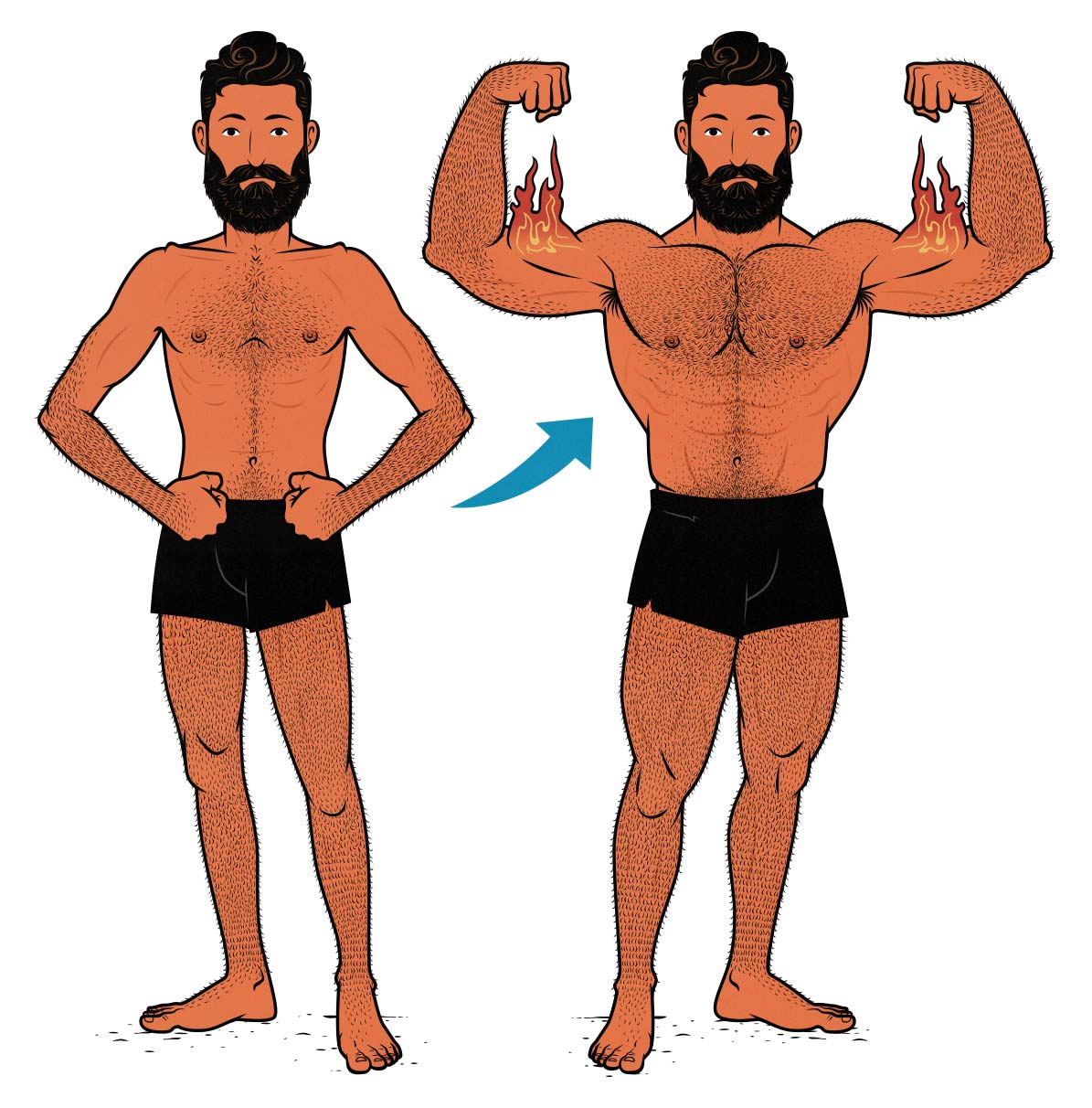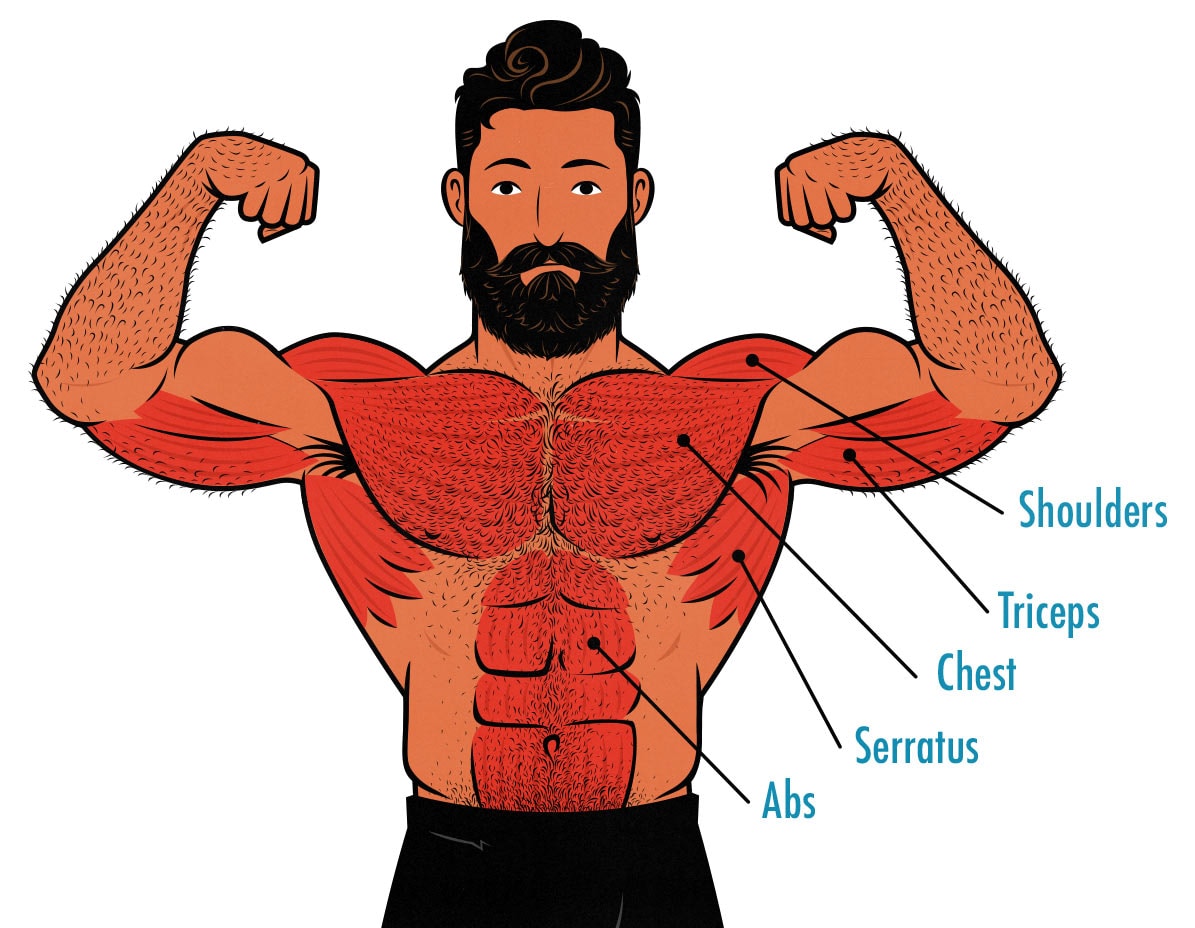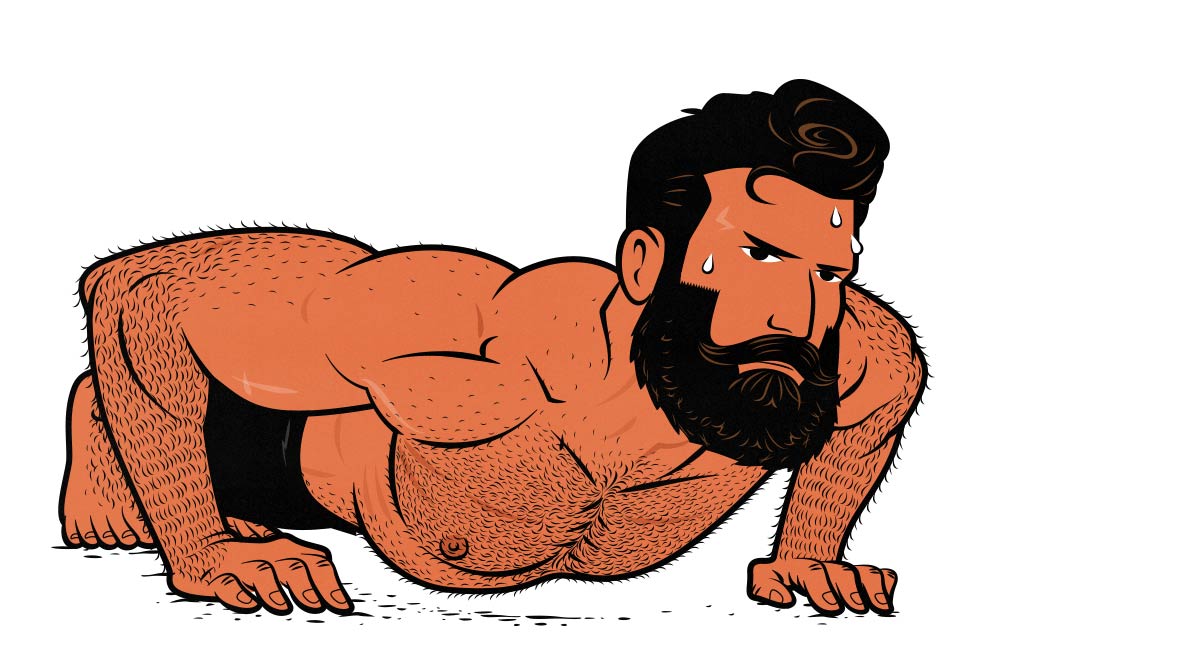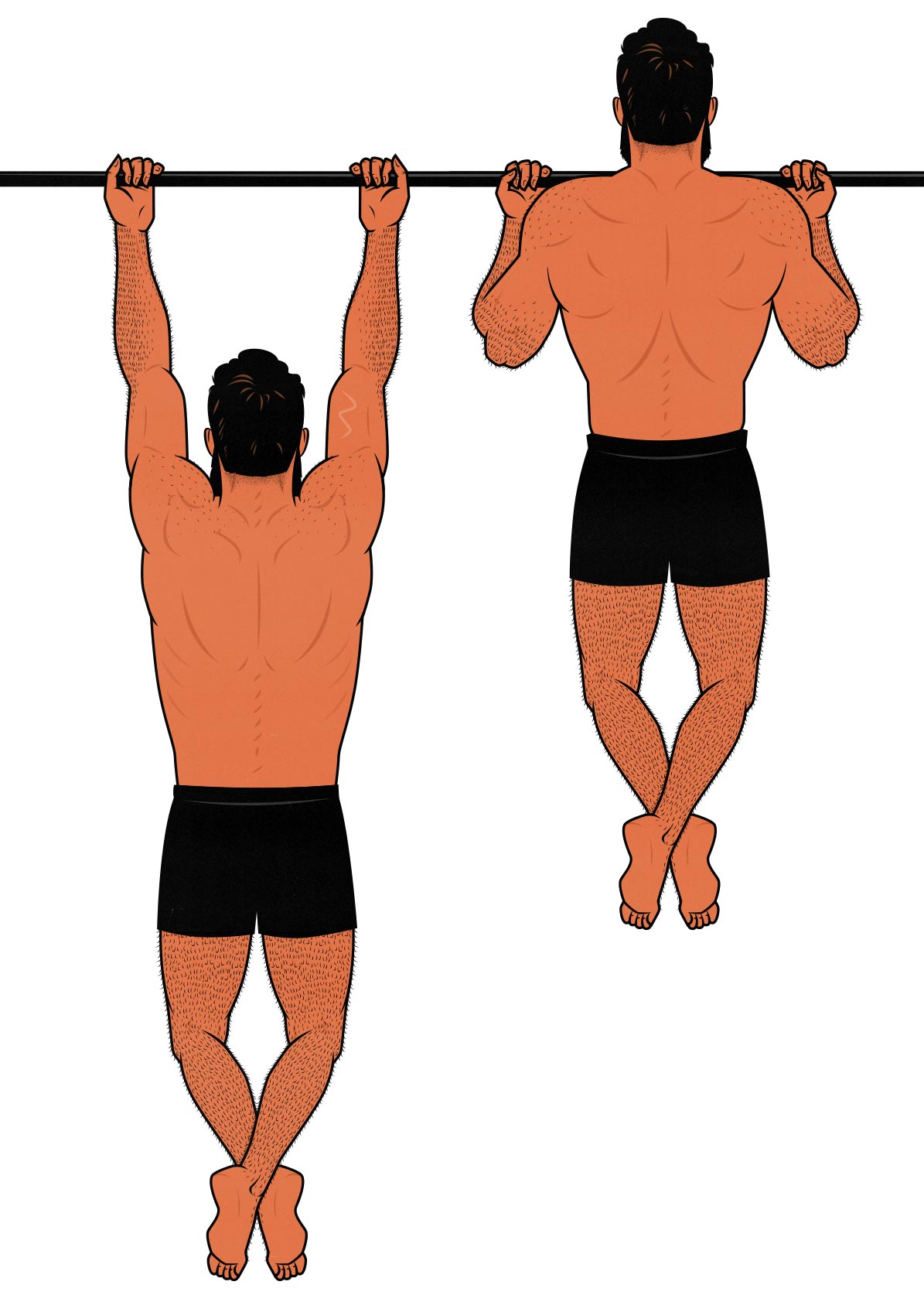
100 Push-Ups a Day? You Can Do Better
The 100 Push-ups a Day Challenge is when you do 100 push-ups every day, usually for 30 days in a row. The goal is to improve your strength and fitness, building a bigger upper body as you go. It’s an admirable challenge. It’s also controversial.
Muscles take 2–4 days to recover from a strenuous workout. It’s during those days of recovery that they grow bigger and stronger. You won’t gain more muscle and strength by doing push-ups every day. In fact, you may gain less.
On the other hand, repeating the same exercise every day is a great way to practice your form. It can be great for your health and fitness, too. But if that were your goal, you’d want to keep your workouts easier. That way, you aren’t accumulating muscle damage.
The final problem is that push-ups work your chest, shoulders, triceps, and a slew of postural muscles in your torso. That’s fantastic. Push-ups are one of the best muscle-building exercises. Still, that leaves 3/4 of your body untrained.
We can solve all these problems, creating a much better challenge.

How to Do 100 Push-Ups a Day
Here’s how to do the 100 Push-Ups a Day Challenge:
- The Challenge: The challenge is simple. You need to do 100 push-ups every day. You don’t need to do them all at once. Take as many breaks as you need. Maybe that means doing 2 sets of 20 reps before breakfast, another 2 sets before lunch, and a final set before dinner.
- Track Your Progress: Write down how many push-ups you do every set and how many sets it takes to reach 100. The goal is to get better over time.
- Survive All 30 Days: The classic version of the push-up challenge lasts for 30 days. After those 30 days, you can look at your results, celebrate, and set new goals.
It’s a fine challenge. Your muscles won’t fall off. But you might not get the muscle and strength gains you were hoping for. We can fix that.
Push-Ups Are An Incredible Exercise
Push-ups are one of the best exercises, bar none. They’re one of the best exercises for building muscle, gaining strength, and improving your appearance. They rival the bench press for building a bigger chest, and they come with the added benefit of bulking up your core and serratus muscles. Your serratus muscles are important postural muscles that move your shoulder blades around. They’re also quite big, and making them even bigger will make you look even better.

The other advantage of push-ups is you can do them at home. No equipment is required. Just drop to the floor and start stimulating muscle growth.
Building a 30-day challenge around push-ups is a great idea. Let’s keep what’s working, fix what isn’t, and build upon it.
Making the Challenge Better
Let’s say you want to spend the next 30 days building muscle at home. Doing 100 push-ups a day isn’t the best way to do that. We can switch three variables to get you much better results:
- Alternate between different exercises. Maybe one day you do push-ups (a push exercise), the next you do chin-ups (a pull exercise), and the next you do split squats (a leg exercise). Another option is to alternate between push-up days and walking days. By alternating between different workouts, you give your muscles time to grow before you train them again.
- Adjust the difficulty of the exercises. Different people have different levels of strength. Push-ups will be too easy for some, too hard for others. We can fix that by letting you raise your hands up on a bench (making the push-ups easier) or raising your feet up (making the push-ups harder).
- Do 3 sets, count the reps, and build from there. 3 challenging sets are enough to maximize your rate of muscle growth, at least for now. Count how many reps you get, and every time you repeat the same workout, do more reps than before. That’s progressive overload. It’s one of the most important principles of muscle growth.
Let’s build these into three different challenges, one for improving your fitness, the other for building muscle, and the third for doing both at once. Choose the one you prefer.

30-Day Fitness Challenge
If you decide to alternate between push-up days and walking days, your chest will grow just as fast as if you did push-ups every day, and perhaps even faster.
- Monday: push-ups for 3–6 sets.
- Tuesday: walk for 30–60 minutes.
- Wednesday: push-ups for 3–6 sets.
- Thursday: walk for 30–60 minutes.
- Friday: push-ups for 3–6 sets.
- Saturday: walk for 30–60 minutes.
- Sunday: rest.
The walking days are to improve your fitness. If you walk briskly for 30 minutes every second day, you’ll hit the weekly cardio recommendations. This is a great way to get in shape.
- Choose a push-up variation: If you’re new to push-ups, raise your hands up on a bench. The higher you raise your hands, the easier they’ll be. If you can do 10–20 push-ups, do classic push-ups from the floor. If you can do more than 20 push-ups, raise your feet up on a bench.
- Start with 3 sets of push-ups, adding an extra set every week. Your muscles will be sensitive at first. It won’t take much to stimulate muscle growth, and it’s easy to overdo it. But your muscles will quickly grow tougher, allowing you to benefit from doing more. Every week, add an extra set. By the end of the month, you can do up to 6 sets per exercise.
- Start with 30-minute walks, adding 10 minutes every week. Just like with push-ups, start small and work your way up.
- Every time you repeat a workout, do more than before. Try to get more total reps or walk a little bit further. For example, let’s say you got 10 push-ups in your first set, 9 in your second, and 8 in your third. That’s 27 total reps. Next workout, try to get at least 28.

30-Day Muscle-Building Challenge
If you decide to alternate between push-ups, chin-ups, and squats, you’ll stimulate all the major muscle groups in your body, keep them growing all week long, and recover properly between workouts. As a result, you’ll gain far more muscle and strength.
- Monday: push-ups for 3–6 sets each.
- Tuesday: pulls for 3–6 sets each.
- Wednesday: squats for 3–6 sets each.
- Thursday: push-ups for 3–6 sets each.
- Friday: pulls for 3–6 sets each.
- Saturday: squats for 3–6 sets each.
- Sunday: rest.
This is a bodyweight Push/Pull/Legs split. The workouts are short. You can finish them in under 20 minutes. But they get you exercising every day, steadily stimulating muscle growth. That adds up, giving you great results by the end of the month.
How to choose your exercises:
- Choose a push-up variation: If you’re new to push-ups, raise your hands up on a bench. The higher you raise your hands, the easier they’ll be. If you can do 10–20 push-ups, do classic push-ups from the floor. If you can do more than 20 push-ups, raise your feet up on a bench.
- Choose a pull exercise: chin-ups make for the best default. If you aren’t strong enough to do 5 or more reps, that’s okay. If you’re using a pull-up bar, get a stool, start from the top position, and lower yourself down as slowly as you can for 5 reps per set. If you have gymnastic rings, lower them closer to the floor and do inverted rows.
- Choose a lower-body exercise: To build stronger legs, think of air squats, jump squats, step-ups, or lunges. Choose a variation that lets you do somewhere between 5–20 reps. Starting with air squats and progressing to jump squats is a good default.
How to do the muscle-building challenge:
- Alternate between the Push, Pull, and Leg days. Push-ups on Monday, chin-ups on Tuesday, squats on Wednesday, and so on.
- In the first week, do 3 sets of every exercise. Write down how many reps you get in each set.
- Every time you repeat a workout, fight to get more reps than before. Let’s say you got 20 reps in your first set, 17 in your second, and 15 in your third. That’s 52 total reps. Next workout, try to get at least 53.
- Add a set every week (optional). When you first start working out, your muscles are sensitive. It doesn’t take much to stimulate muscle growth. It’s easy to overdo it. But your muscles will quickly grow tougher, allowing you to benefit from more challenging workouts. Every week, you can add an extra set. By the end of the month, you can do up to 6 sets per exercise.
- Eat enough to fuel muscle growth. If you’re skinny-fat or overweight, your body fat has enough extra energy to fuel muscle growth, so just keep eating according to your appetite. If you’re thin, you’ll need to get your extra energy by eating more food.

30-Day Outlift Challenge
The Outlift Challenge is a combination of the muscle-building challenge and the fitness challenge. It’s harder, and it takes longer, but it offers the best of both workout routines. It’s a great way to build muscle and get in shape.
- Monday: push-ups, pulls, and squats for 3–6 sets each.
- Tuesday: walk for 30–60 minutes.
- Wednesday: push-ups, pulls, and squats for 3–6 sets each.
- Thursday: walk for 30–60 minutes.
- Friday: push-ups, pulls, and squats for 3–6 sets each.
- Saturday: walk for 30–60 minutes.
- Sunday: brief respite.
In this challenge, you’ll do all 3 exercises as a full-body workout. The next day, you’ll go for a walk. The day after that, you’ll do another full-body workout.
How to choose your exercises:
- Choose a push-up variation: If you’re new to push-ups, raise your hands up on a bench. The higher you raise your hands, the easier they’ll be. If you can do 10–20 push-ups, do classic push-ups from the floor. If you can do more than 20 push-ups, raise your feet up on a bench.
- Choose a pull exercise: chin-ups make for the best default. If you aren’t strong enough to do 5 or more reps, that’s okay. If you’re using a pull-up bar, get a stool, start from the top position, and lower yourself down as slowly as you can for 5 reps per set. If you have gymnastic rings, lower them closer to the floor and do inverted rows.
- Choose a lower-body exercise: To build stronger legs, think of air squats, jump squats, step-ups, or lunges. Choose a variation that lets you do somewhere between 5–20 reps. Starting with air squats and progressing to jump squats is a good default.
How to do the Outlift Challenge:
- Do all 3 exercises every workout. Push-ups, then chin-ups, then squats. You do that full-body bodyweight workout every Monday, Wednesday, and Friday.
- Start with 3 sets of each exercise, adding an extra set every week. Your muscles will be sensitive at first, but they’ll quickly grow tougher, allowing you to benefit from doing more. Every week, add an extra set. By the end of the month, you can do up to 6 sets per exercise.
- Every time you repeat a workout, fight to get more reps than before. Let’s say you got 15 reps in your first set, 13 in your second, and 12 in your third. That’s 40 total reps. Next workout, try to get at least 41.
- Go on a walk every second day. Start with 30-minute walks, adding 10 minutes every week. Just like with push-ups, start small and work your way up.
- Eat enough to fuel muscle growth. If you’re skinny-fat or overweight, your body fat has enough extra energy to fuel muscle growth, so just keep eating according to your appetite. If you’re thin, you’ll need to get your extra energy by eating more food.
What Next?
If you finish the 30-day push-up challenge, congratulations! How was it? What will you do next? Let me know in the comments.
If you want to take your training to the next level, you could get a pair of adjustable dumbbells, build a barbell home gym, or join a commercial gym. Once you have access to weights, the whole world of hypertrophy training opens up before you. But that’s something you can consider 30 days from now, when your chest is wide, your shoulders broad, and your legs sturdy enough to support them.
Alright, that’s it for now. If you want more muscle-building information, we have a free muscle-building newsletter. We’ll keep you updated on all the latest research and methods.
Questions?
Ask away. I’ll answer every comment.



Less a question than a comment. The 100/day is pretty much part of my default pre-lifting session (with pull-ups, ab wheel, and weighted sumo squats). I’m glad you mentioned the chin-ups. You read those horror stories of those who go nuts on pushups and regular chest exercises seeing their shoulders hunching into their chest! Pull-ups are great, too, at least for more activation of the lats than biceps. Nice to break up chest training with back training. (I confess to doing agonist-antagonist days.)
Thank you, man! Agonist-antagonist days are great. Gives you a ton of great options for supersets.
Yeah, people can do pull-ups instead of chin-ups if they want. Or do pull-ups one day, chin-ups the next. While learning good technique, repetition gives you more practice. After you’ve learned how to do the exercises, variety can lead to more balanced muscle growth.
Science be damned. I do 500-1,000 pushups daily, along with 125 squats, leg raises, and a faux pull-up I do through my Bowflex.
I’m never sore, and I’ve never seen this type of body composition changes beforehand. And yes, that’s comparing it to free weights and resistance band exercises. I absolutely love what I’m doing, can stay consistent with it (at least 5 days a week), and I’m showing significant muscle growth.
Maybe I’m an outlier; maybe I’d grow more with alternate day exercises, but I’ve been on this regimen for six months, and I’ve never felt better.
That’s awesome, man! Congratulations on the all the gains!
I don’t think you’re defying science. People adapt to higher training volumes. Doing lots of resistance training is good for building muscle. Training consistently leads to reliable growth. Sounds like you’ve found a good routine, you’re following it, and you’re reaping the rewards. That’s fantastic. You’re killing it.
Absolutely love this haha, its almost the same thing Ive been doing recently just slightly more simple (I do 3 different pushup variations and mix chinups with pullups). Except for the walking. I cant afford to burn more energy at the moment. I cant afford to eat enough, and more walking would just make me burn more energy, which would be a bad thing in my specific scenario.
That sounds like a great routine! Once someone learns how to do push-ups and chin-ups, mixing in other variations can be wise. Less repetitive strain on your joints, more muscle fibres being stimulated.
I know you’ve been going through a dark time. I hope your hard work pays off soon, rewarding you with some extra luck.
How about developing tendons such as the medial common flexor tendon first to help reduce injury from doing a 100 pushup challenge?
Hey Dan, I think it depends on what your goal is.
If your goal is to finish the challenge for the sake of the challenge, it makes sense to prepare for it. You could work on developing tougher muscles and tendons. You could also work on your technique. Good push-up technique can greatly reduce your risk of running into elbow issues.
An easy way to prepare is to do push-ups, rest, recover, and then do more push-ups. So, for example, you could do a balanced routine as outlined in this article. You can gain a bunch of muscle and strength that way, too, allowing you to do more push-ups more easily. That way when you start the push-up challenge, you’ll be better prepared for it. The workouts won’t make you as sore or beat you up as much.
If your goal is to get better at push-ups, build muscle, gain strength, or improve your fitness, then you don’t need to do the challenge at all. Instead, you could follow a more reasonable push-up program. That way you’d be much less likely to run into overuse injuries (such as golfer’s elbow).